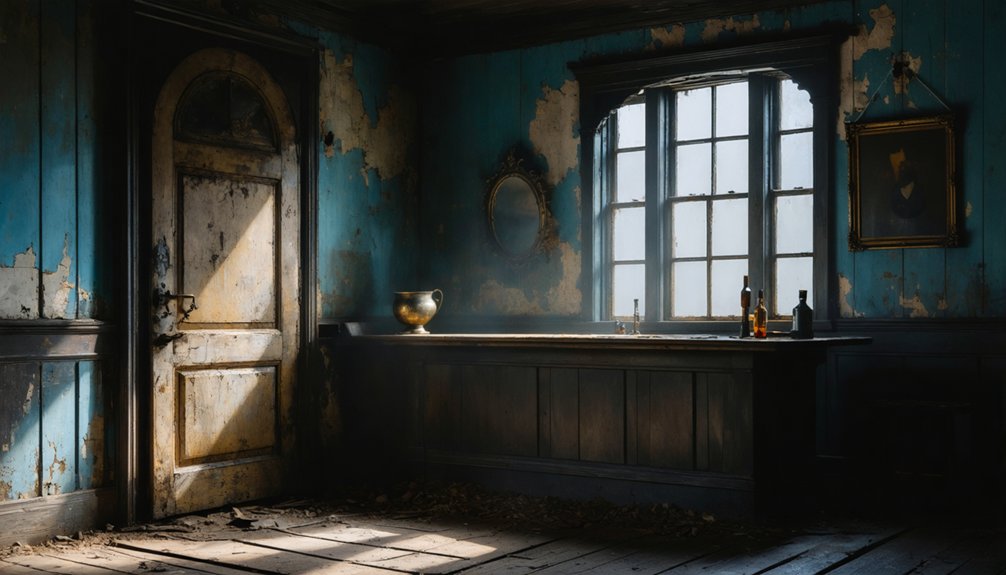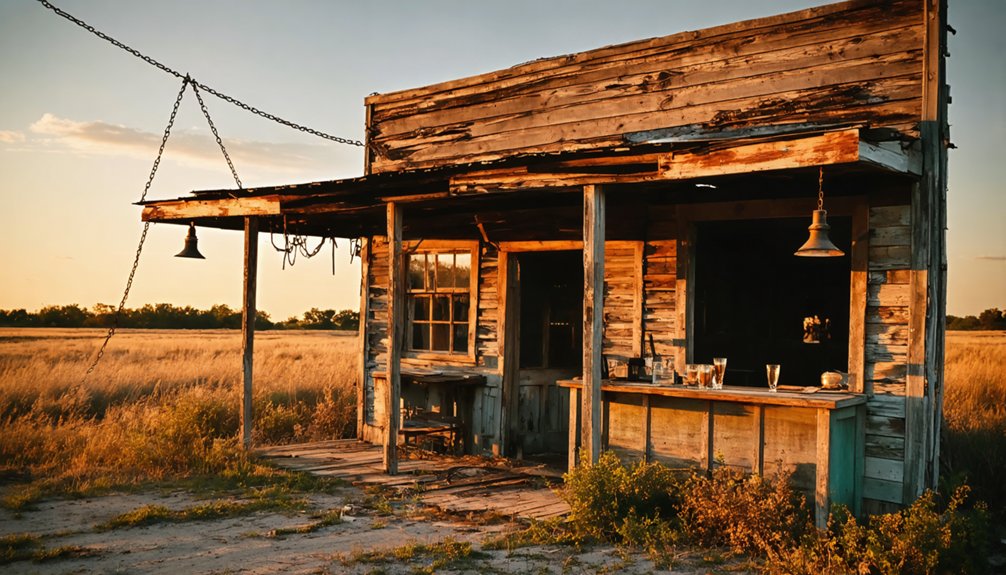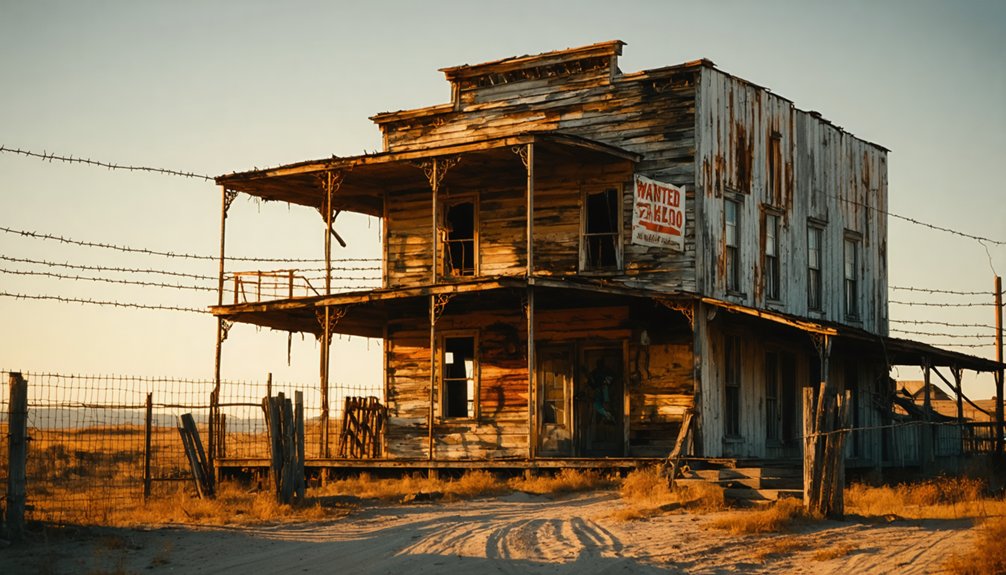To explore haunted Texas ghost towns safely, pack sturdy boots, gloves, and reliable lighting equipment. Research local legends beforehand and verify access permissions, as many sites sit on private property. Midnight to 3:00 AM offers ideal conditions for paranormal activity, especially during new moons or historical anniversaries. Document your findings with EMF meters and digital recorders while respecting structural hazards and potential spirits. The weathered walls of these abandoned settlements hold secrets beyond mere historical curiosity.
Key Takeaways
- Always bring essential gear including sturdy boots, gloves, headlamps with backup batteries, and a first aid kit.
- Conduct thorough research on local legends and histories before visiting to enhance your ghost hunting experience.
- Visit during optimal paranormal activity times, typically midnight to 3:00 AM or during seasonal transitions like fall.
- Obtain proper permissions since many ghost towns are on private property or protected historical sites.
- Document potential paranormal activity using EMF meters, digital voice recorders, and infrared cameras while maintaining objective analysis.
Understanding the Historical Significance of Texas Ghost Towns
While exploring the haunted remnants of Texas ghost towns, one must first comprehend the complex historical foundations that birthed these now-abandoned settlements.
These forgotten places emerged during the 19th century as vibrant centers of mining, agriculture, and transportation, reflecting Texas’s economic booms and subsequent busts.
You’ll discover that understanding the historical context enhances your exploration—each crumbling structure tells a story of rapid prosperity followed by economic decline.
Towns like Terlingua (mercury mining) and Shafter (silver) showcase how resource depletion triggered abandonment, while others like Independence fell victim to railroad bypasses.
Natural disasters, such as the hurricanes that destroyed Indianola, and social conflicts, exemplified by Helena’s feud-driven decline, further shaped these settlements’ fates.
These ghost towns aren’t merely abandoned places—they’re living museums of Texas’s developmental patterns.
Places like Thurber illustrate how thriving towns with over 10,000 residents and luxurious amenities could collapse when coal mining declined and industrial priorities shifted.
Documenting these sites through photographs and detailed descriptions serves as an important historical archive, as many structures deteriorate rapidly due to environmental factors.
Essential Gear for Ghost Town Exploration
When exploring Texas ghost towns, you’ll need to equip yourself with essential safety gear including sturdy hiking boots, gloves, helmets, and respirator masks to protect against structural hazards and environmental risks.
Your exploration kit should also contain reliable lighting equipment such as headlamps and backup flashlights with extra batteries, ensuring visibility in abandoned structures and darkened spaces. A portable battery is vital for keeping devices charged during extended trips into remote locations.
For those interested in paranormal investigation, consider supplementing your basic equipment with specialized ghost hunting tools like EMF meters, digital recorders, and infrared cameras to document any unusual phenomena you might encounter. Remember to bring a first aid kit to address minor injuries that might occur during your exploration.
Safety Gear Essentials
Proper preparation with specialized safety equipment constitutes the foundation of responsible ghost town exploration. Your protective arsenal should include sturdy hiking boots with thick soles, cut-resistant gloves, and breathable long-sleeved clothing that shields against environmental hazards while allowing mobility for ghost town photography.
Respiratory protection remains non-negotiable—certified particulate masks defend against the invisible threats of historic dust and mold that compromise both health and exploration etiquette.
Supplement with safety goggles to preserve visual clarity when maneuvering through deteriorated structures.
Illumination redundancy—headlamps, high-lumen flashlights, and backup light sources—prevents disorientation in shadowed interiors. Modern hands-free headlamps provide consistent illumination exactly where needed while allowing you to climb or handle artifacts safely.
Complete your toolkit with navigation instruments (GPS devices with offline capabilities, physical maps) and extensive first aid supplies to address inevitable minor injuries during your investigative pursuits. Remember to carry a mobile phone for emergency communication and documenting any paranormal encounters during your exploration.
Ghost Hunting Equipment
Beyond basic safety equipment, serious ghost town explorers incorporate specialized paranormal detection instruments that transform amateur outings into methodical investigations.
An EMF meter serves as your primary tool, detecting electromagnetic anomalies that distinguish paranormal presences from natural field variations. Cross-verification of findings using multiple devices enhances the credibility of your ghost town investigation results. Complement this with a digital voice recorder to capture EVPs—potential spirit communications inaudible to the human ear during your exploration.
Your paranormal investigation tools should include thermal or infrared cameras that document visual anomalies and temperature fluctuations. Always bring extra batteries to ensure your devices remain operational throughout the entire investigation.
For advanced ghost hunting techniques, consider REM pods or spirit boxes that facilitate potential communication with entities. Temperature measuring devices help identify cold spots—often considered evidence of spiritual energy.
This systematic approach elevates your exploration from mere tourism to scientific inquiry, documenting phenomena for objective analysis.
Planning Your Route Through Haunted Territory
How can you effectively navigate the spectral landscape of Texas’s abandoned settlements? Begin by leveraging specialized resources like Forgotten Lands or GeoSpirits maps that provide precise coordinates and historical context for over 500 documented ghost towns.
Begin your spectral journey armed with specialized maps that unlock the secrets of Texas’s forgotten realms.
Organize your expedition geographically, clustering destinations by region—East Texas, Hill Country, or West Texas—to maximize efficiency and ghost town photography opportunities.
Prioritize locations with both substantiated haunted folklore and physical remnants, ensuring a balance between paranormal pursuits and tangible historical exploration.
Allow additional travel time for rural roads, and verify access permissions before departing, as many sites reside on private property.
Consider anchoring your journey around established ghost tours or seasonal paranormal events, particularly during Halloween when spectral activity reportedly intensifies, though year-round exploration remains viable with proper preparation.
Remember to research towns like Tascosa that have been transformed into educational facilities such as Cal Farley’s Boys Ranch, offering a unique glimpse into how abandoned communities can find new purpose.
Include the Haunted Fredericksburg Ghost Walk in your itinerary for a structured introduction to paranormal investigation techniques while enjoying the BYOB option for added relaxation during your ghostly encounters.
Safety Precautions for Abandoned Structures
Venturing into abandoned structures across Texas’s ghost towns requires thorough safety protocols that extend beyond mere supernatural concerns. Assess structural integrity before entry—look for sagging floors, cracked walls, and compromised support beams.
Position yourself near load-bearing walls rather than room centers where collapse risk peaks. Prior research proves invaluable: buildings constructed before the 1980s likely contain asbestos. Always wear appropriate protective gear—N95 respirators shield against health risks from mold, dust, and deteriorating materials.
Your footwear should provide ankle support for maneuvering through debris-strewn floors. Map your exit routes meticulously and mark your path with removable indicators. Remember to inform a trusted contact of your exploration timeline.
Ghost towns offer freedom to discover history, but this liberty demands rigorous preparation and situational awareness.
Best Times to Witness Paranormal Activity
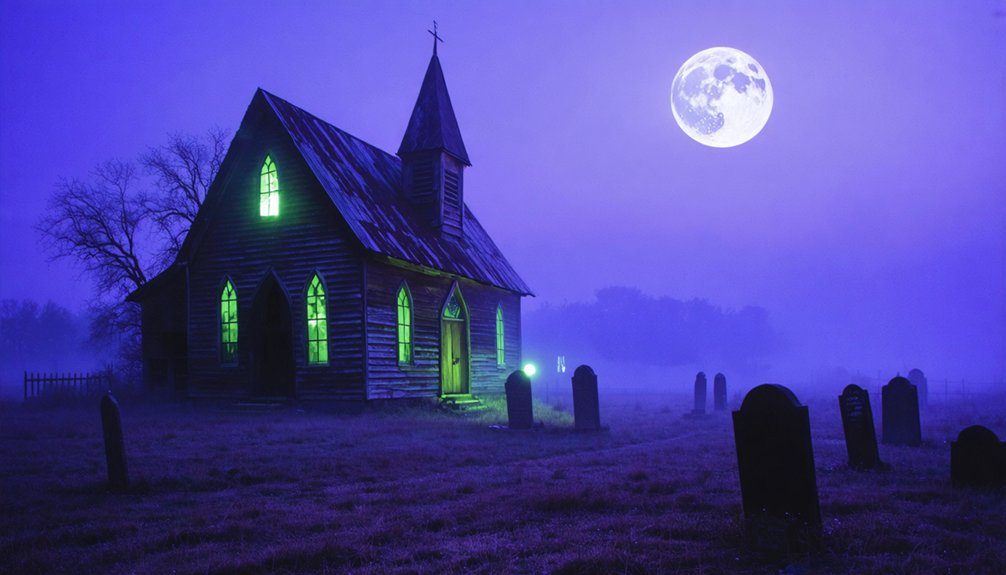
Timing your exploration of Texas ghost towns proves as significant as the safety measures themselves when seeking paranormal encounters.
Research consistently shows that midnight to 3:00 AM offers ideal conditions for manifestations, particularly during the new moon when darkness envelops these paranormal hotspots completely.
Late fall through early winter, especially around Halloween, coincides with peak supernatural activity.
Pre-dawn hours and periods of weather changes—thunderstorms or approaching cold fronts—frequently trigger unexplained phenomena.
For location-specific hauntings, align your visits with historical anniversaries of tragic events that shaped the town’s ghostly folklore.
Environmental factors enhance your chances: seek complete silence, minimal artificial light, and areas with natural fog or mist.
Cold spots and sudden temperature drops often signal a spectral presence worth investigating with proper equipment.
Documenting Your Supernatural Encounters
Proper documentation serves as the cornerstone of credible paranormal investigation when exploring Texas ghost towns, transforming fleeting spectral experiences into analyzable evidence.
Before visiting, research local legends and secure necessary permissions while assembling your documentation toolkit: digital recorders for EVPs, cameras with infrared capabilities, and environmental sensors.
During your expedition, establish baseline readings, maintain continuous recordings, and meticulously timestamp all observations. Note every fluctuation in temperature, EMF spikes, and team members’ sensory perceptions.
Your ghostly encounters gain credibility through systematic evidence analysis—review recordings for unexplained voices, examine photographs for anomalies, and cross-reference environmental data with reported phenomena.
Remember to maintain objectivity when interpreting findings. The most compelling supernatural documentation combines multiple evidence types while avoiding suggestive questioning or sensationalizing your discoveries.
Respecting the Spirits and Their Resting Places

When exploring Texas’s spectral landscapes, you’ll demonstrate respect by honoring cemetery boundaries and never crossing into marked burial grounds without proper authorization.
Historical artifacts, no matter how seemingly insignificant, must remain in their original locations as they form integral connections between the spiritual and physical domains.
Before attempting communication with potential spirits, you should first listen attentively to the ambient environment, allowing any supernatural presence to establish comfort with your presence rather than immediately demanding interaction.
Honor Cemetery Boundaries
Nearly every ghost town cemetery in Texas represents both a sacred historical record and a legally protected site with clearly defined boundaries that visitors must respect. Texas law protects these sites upon dedication through burial, regardless of formal documentation.
When practicing grave marker etiquette, avoid stepping on plots or leaning against stones, which damages these historical artifacts. Always secure permission before entering cemeteries on private land, even if they appear abandoned. Unauthorized excavation or artifact removal carries legal penalties.
During respectful visitation, keep decorations within plot boundaries and adhere to posted hours. Remember that these grounds often contain culturally distinct sections reflecting diverse Texas heritage.
The segregated areas and family plots tell important stories about our past. By honoring physical and spiritual boundaries, you preserve both the historical integrity and cultural significance of these sacred spaces.
Leave Artifacts Behind
Respecting cemetery boundaries extends beyond the physical perimeters to the artifacts that remain within ghost towns across Texas. These items—weathered tools, faded photographs, or simple household objects—carry cultural significance and spiritual energy that shouldn’t be disturbed.
Texas law reinforces this spiritual respect, prohibiting removal of artifacts over 100 years old without proper authorization.
When exploring, document these historical treasures through photography rather than collection. Artifact preservation isn’t merely legal compliance but acknowledges the connection between physical objects and the spirits that once owned them.
Listen Before Speaking
Why do experienced paranormal investigators insist on silence during ghost town explorations? The answer lies in both pragmatism and respect.
Silent observation creates ideal conditions for detecting subtle auditory phenomena—whispers, footsteps, or unexplained sounds that might indicate spectral presence. Your quiet demeanor serves as acknowledgment of these locations’ sacred nature, particularly in areas with Native American heritage like Medicine Mound.
Respectful listening enhances your awareness of potential hazards while maximizing opportunities for paranormal encounters. EVP recordings require minimal ambient noise for clarity.
You’ll find that maintaining silence not only follows established community guidelines but connects you more deeply to the historical essence of these abandoned places. Many visitors report stronger spiritual connections when embracing quietude.
This practice honors former residents’ memories while potentially increasing your chances of meaningful paranormal experiences.
Local Legends That Enhance Your Experience
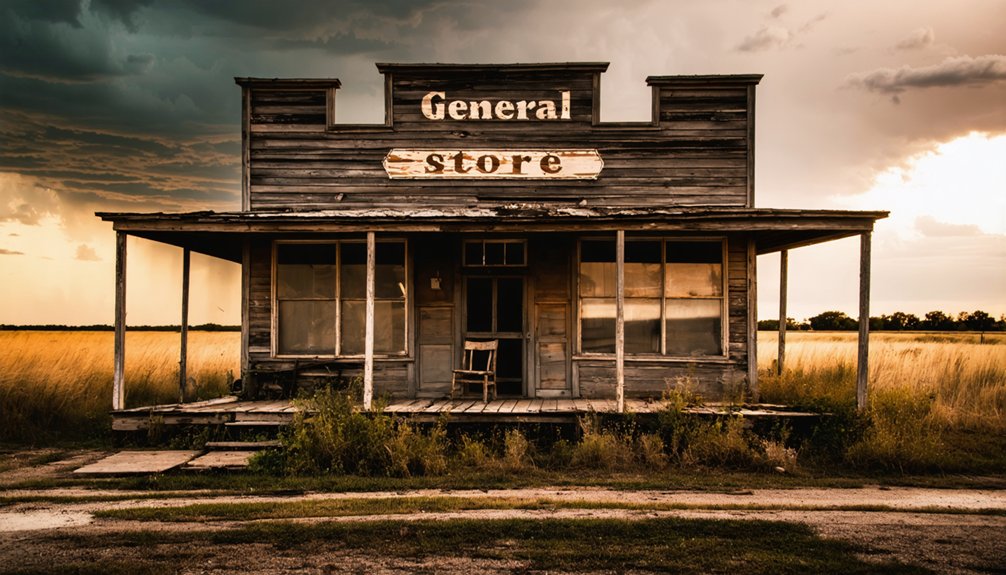
When exploring the spectral landscape of Texas ghost towns, local legends serve as the cultural bedrock that transforms mere abandoned settlements into immersive paranormal experiences.
Research signature stories like La Llorona’s mournful cries near waterfront areas or the vengeful La Lechuza before your journey. These narratives contextualize potential ghostly encounters you’ll experience at locations like Jefferson, often cited as Texas’s most haunted town.
Pay particular attention to tales connected to violent historical events—the Alamo’s spectral defenders or Helena’s infamous feuds offer rich local lore.
Demon’s Road in Huntsville and Goatman’s Bridge in Copper Canyon represent haunted thoroughfares where paranormal activity intensifies after dark.
Understanding Native American legends surrounding Enchanted Rock or the controversial hanging of Chipita Rodríguez near the Nueces River adds historical depth that considerably enhances your ghost town exploration.
Joining Organized Ghost Tours vs. Solo Adventures
When considering your exploration of haunted Texas ghost towns, organized tours offer professional guidance through potentially hazardous structures and unfamiliar terrain while providing access to restricted locations that might otherwise remain inaccessible.
Your independent adventures, conversely, create opportunities for personalized discovery at your own pace, allowing for spontaneous detours to less-frequented sites that organized groups typically bypass.
You’ll need to weigh the structured safety and historical context of guided experiences against the freedom and deeper personal connection that comes with traversing these spectral settlements on your own terms.
Guided Safety Benefits
Exploring the spectral remains of Texas ghost towns presents travelers with a fundamental choice between guided tours and solitary expeditions, each carrying distinct safety implications.
Guided exploration benefits include trained professionals who maintain constant headcounts and carry emergency equipment, substantially reducing your risk of becoming lost or injured without assistance.
Ghost tour safety extends beyond physical protection—operators secure legal permissions for property access, preventing potential trespassing charges you might unwittingly incur alone.
Guides monitor weather conditions, implementing contingency plans when environmental threats emerge. Their first aid training and established emergency protocols guarantee swift response to medical incidents or accidents.
Additionally, you’ll receive educational briefings highlighting potential hazards before venturing into unstable structures, while guides remain vigilant for risky behaviors that could compromise your experience or wellbeing.
Independent Discovery Opportunities
Why might you choose a solitary expedition through Texas ghost towns when guided options abound?
Independent exploration grants you methodical control over your investigative process. You’ll set your own pace, lingering at architectural remnants or potential paranormal hotspots without adhering to prescribed schedules. This autonomy facilitates discovery of hidden gems overlooked by commercial tours.
Your self-directed research through historical archives, local libraries, and digital repositories will unearth nuanced local folklore that organized tours might condense for time efficiency.
You’ll gain freedom to document findings extensively, pursue spontaneous detours to unexplored structures, and visit during ideal atmospheric conditions—dawn, dusk, or midnight hours—when paranormal sensitivity potentially peaks.
In addition, your solitary presence may heighten perceptual acuity to subtle environmental anomalies that larger groups might inadvertently disrupt through collective movement and conversation.
Preserving Ghost Town Heritage for Future Explorers
The preservation of ghost town heritage across Texas represents a complex interplay of community action, government oversight, and sustainable planning that guarantees these abandoned settlements remain accessible for generations to come.
You’ll find local residents forming preservation committees and organizing festivals that fund vital maintenance efforts. These community involvement initiatives work alongside official preservation strategies from the Texas Historical Commission and federal programs that protect landmarks through National Register designations.
When you explore these sites, you’re benefiting from adaptive reuse techniques that maintain historical integrity while accommodating modern visitors.
The legal safeguards enforced by preservation officers guarantee that even when redevelopment occurs, the site’s historical relevance remains intact.
Frequently Asked Questions
Can Children Safely Participate in Ghost Town Explorations?
You’ll find children can safely participate when you prioritize ghost town safety measures, stick to daylight visits, provide supervision, avoid unstable structures, and focus on family friendly activities that are historically educational.
Are Paranormal Encounters More Common in Mining Towns Versus Farming Communities?
Where there’s smoke, there’s fire. You’ll encounter more paranormal activity in mining towns due to their tragic mining history of accidents and deaths compared to farming culture’s more stable, generational population patterns.
How Do Weather Conditions Affect Paranormal Activity?
Weather patterns greatly impact paranormal activity, with thunderstorms and heat waves amplifying manifestations. You’ll notice seasonal influences as atmospheric energy fluctuates, potentially providing spirits the kinetic energy they need to materialize and interact.
What Permissions Are Needed to Conduct Overnight Paranormal Investigations?
Like moths seeking light in darkness, you’ll need written property owner consent, investigation permits, and compliance with local ordinances. Secure property access documentation and liability waivers before conducting overnight paranormal studies.
Can Spirits or Entities Follow Visitors Home From Haunted Locations?
Research suggests ghostly attachments can indeed follow you home, especially when you’ve disturbed strong energy signatures. Your emotional state may facilitate this transference, as indicated by the 28% who documented unexplained phenomena on home security systems.
References
- https://texashighways.com/travel-news/four-texas-ghost-towns/
- https://texastraveltalk.com/local-haunts-to-visit-texas/
- https://texappealmag.com/texas-ghost-towns-explore-haunting-remnants-of-forgotten-cities/
- https://texashighways.com/culture/get-all-the-scary-details-about-texas-haunted-history-on-these-ghost-tours/
- https://en.wikipedia.org/wiki/List_of_ghost_towns_in_Texas
- https://www.youtube.com/watch?v=HVWjyzoPiNE
- https://www.hipcamp.com/journal/camping/texas-ghost-towns/
- https://www.youtube.com/watch?v=6U-ZGyt5-l4
- https://www.youtube.com/watch?v=bbVM_-giQIE
- https://thc.texas.gov/sites/default/files/2025-01/Question_Answer_Responses_DarkTourismWebinar.pdf
